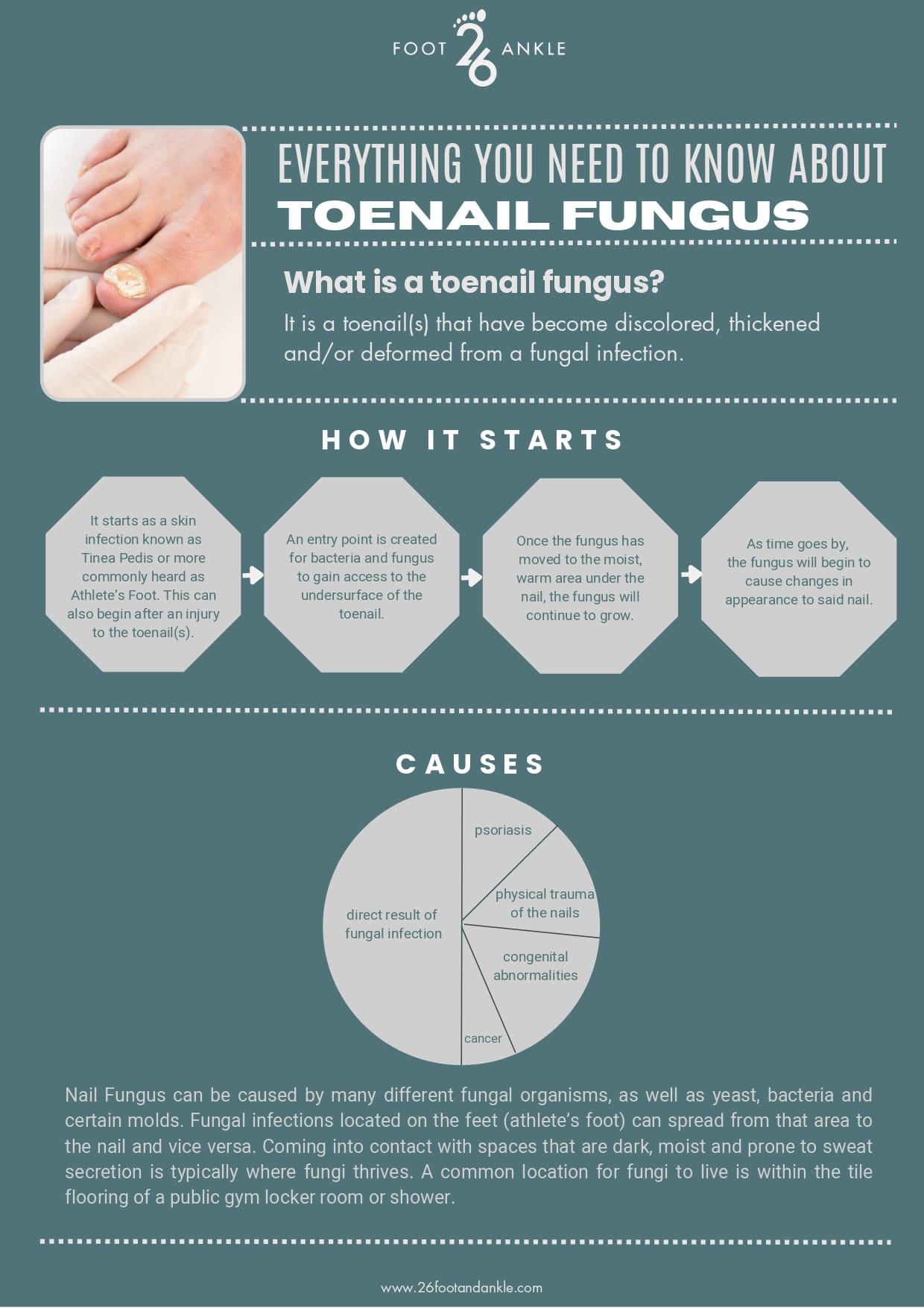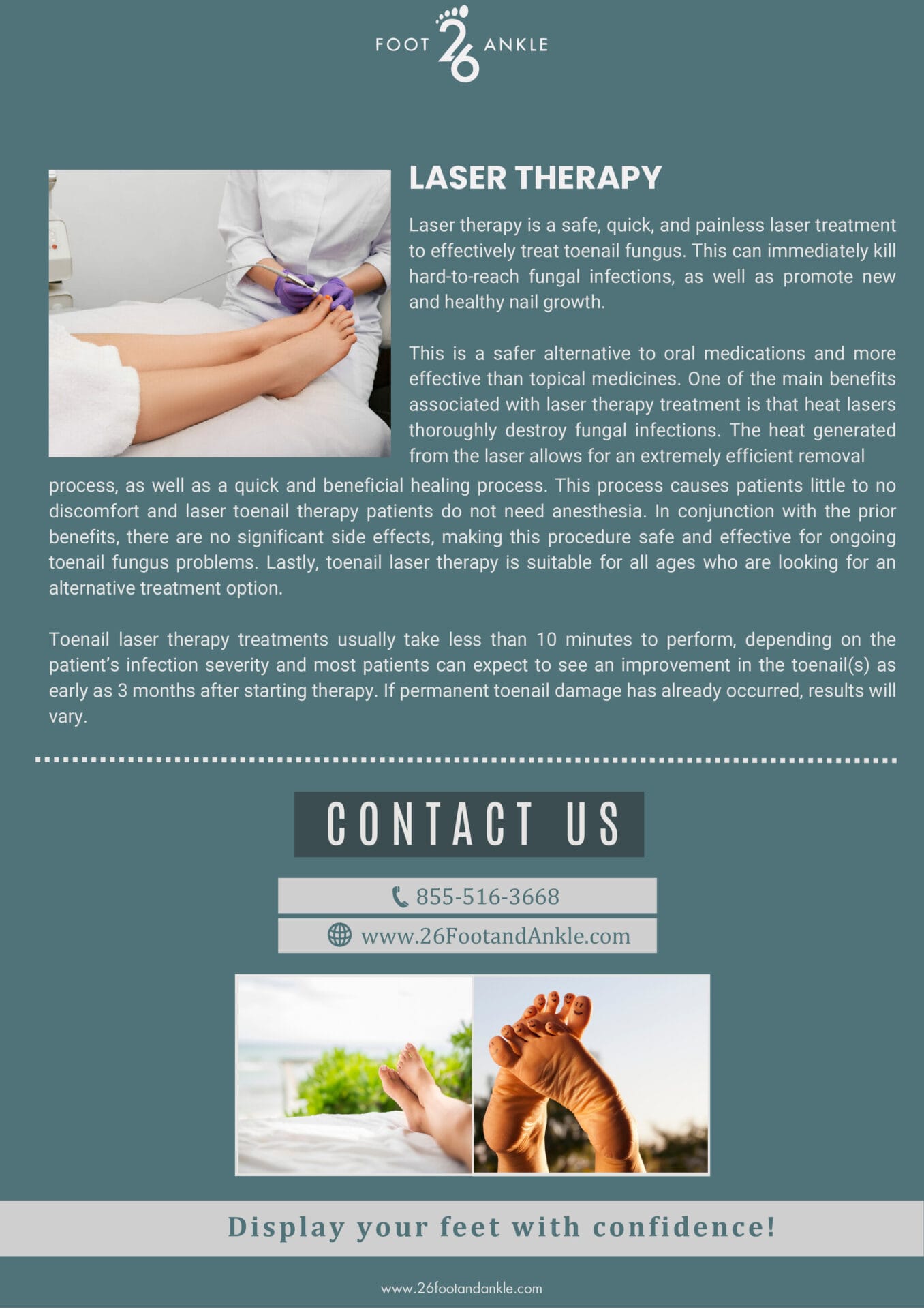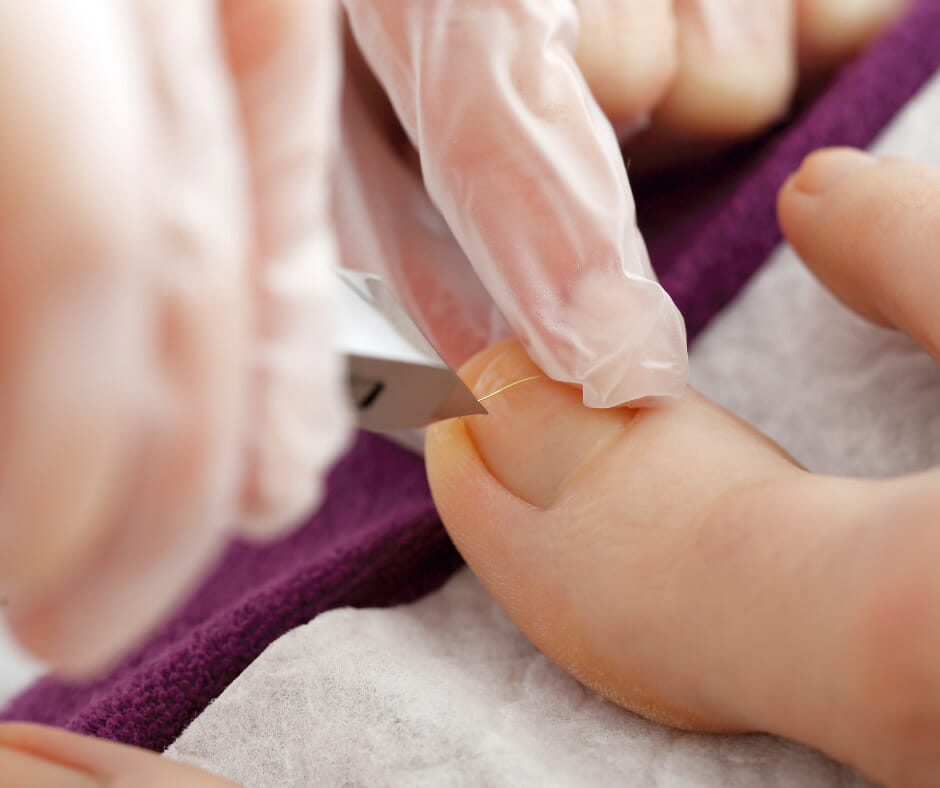The 26 Review
- What is a Fungal Toenail? A toenail(s) that have become discolored, thickened and/or deformed from a fungal infection.
- Causes hereditary genes, trauma, bacteria/fungal infection, age, psoriasis, poor hygiene
- Symptoms cracking, crumbing, unusual curves, abnormal thickness, discoloration (white, brown or yellow hues) drainage, infection
- Diagnosis physical examination, nail biopsy
- Treatment oral antibiotics/anti-fungal, topical medications, in-office procedure, Laser Therapy
Toenails: Toenail Fungus E-Book


TOENAIL FUNGUS
Step into the world of healthy and happy feet! Discover all the information for banishing toenail fungus for good in our latest e-book. Transform your foot care routine and stride confidently with clear, beautiful nails. Download now to a journey of displaying your feet with confidence!

Let’s take a closer look…
Toenail fungus often starts as an infection in the skin known as Tinea Pedis or more commonly heard as Athlete’s Foot. This can also begin after an injury to the toenail(s) in that an entry point is created for bacteria and fungus to gain access to the undersurface of the toenail. Once the fungus has moved to the moist, warm area under the nail, the fungus will continue to grow. As time goes by the fungus will begin to cause changes in appearance to said nail. If you are struggling with Dystrophic Toenails, you may have noticed your nail(s) look thick, oddly shaped and either yellow or brown. Dystrophic nails can be painful, especially when they curve into the skin and in turn can cause ingrown toenails. Although this ailment poses mostly visual signs, those signs may be pointing to a larger problem. Continue reading more to learn about Toenail Fungus, Dystrophic Toenails, how to prevent them, and how to treat them.
Causes
Nail Fungus can be caused by many different fungal organisms, as well as yeast, bacteria and certain molds. Fungal infections located on the feet (athlete’s foot) can spread from that area to the nail and vice versa. Coming into contact with spaces that are dark, moist and prone to sweat secretion is typically where fungi thrives. A common location for fungi to live is within the tile flooring of a public gym locker room or shower. Around 50% of Toenail Dystrophies are a direct result of fungal infections. The remaining various causes can be linked to, but not limited to, Psoriasis, physical trauma of the nail, congenital abnormalities and occasionally cancer. Fungus of the toenail is a common issue that affects people of all ages, however individuals who are older are more commonly affected. Toenail fungus often begins under the nail fold located at the end of the nail. Over time as it grows underneath the nail, you’re likely to see changes in appearance, thickening and physical abnormalities.
Symptoms
If Toenail Fungus is caught early on, avoiding Dystrophic Toenails becomes that much easier. As mentioned before, Athlete’s foot can be a direct cause for the quick progression of Toenail Fungus. Keeping an eye out for itching, stinging and burning sensations between the toes and other parts of the foot will give a clear indication of Athlete’s foot. The skin on the foot may also begin to crack, peel or blister as well. Toenail fungus typically begins as a small light-colored spot on the top of the nail(s). As it spreads deeper, it can change the shape and total color of the nail(s). Over time, it may cause the nail(s) to thicken and/or become more brittle. Common signs of Toenail Fungus include, scaling under the nail, white or yellow streaks under the nail, flakiness of the nail, thick or brittle nails, and lifting off the nail bed. If there are no visible signs of this infection, bad smells wafting from the nail(s) can also be an indicator.
Diagnosis
Individuals of all ages can suffer from Athlete’s foot, however not all cases of Athlete’s foot will lead to Toenail Fungus and/or Dystrophic Toenails. A Clinical physician’s experience and knowledge can aid in differentiating between damaged toenails from trauma and toenails affected from a Toenail Fungus. Your podiatrist may determine a toenail biopsy is necessary to help determine the best course of treatment. Toenail biopsy includes obtaining a portion of the toenail to be observed under a microscope for fungal or bacterial growth. Non-fungal toenail dystrophies may also require a tissue biopsy of the nail plate or nail matrix to make a diagnosis. A Podiatrist clinical experience is the best means of diagnosing and properly treating the toenail.
Treatment
There are many preventative actions you can take to avoid Toenail Fungus and Dystrophic Toenails. Keeping the nail clean and dry, accompanied with regular trimming are great ways to prevent this infection from occurring. However, if it has occurred washing your hands and feet regularly, disinfecting your nail clippers after every use and treating the affected area with antifungal foot powder can aid in minimizing the effects. The footwear worn can also be crucial to preventing and stopping the spread of an infection. Choosing absorbent socks and shoes made out of breathable materials are all smart choices. Wearing footwear in pool areas and locker rooms will also protect the foot and the nail(s) from fungal infections, as well as aid in stopping the spread of said infection to others. It could potentially take weeks to months to treat a toenail infection, so taking all preventative actions is a great place to begin.
Topical antifungal treatments are considered the first-line of treatment for fungal skin infections of the foot. Most topical antifungal treatments are readily available over the counter. Your Podiatrist may prescribe a nail lacquer that’s applied with a brush onto the nail, much like nail polish. If topical treatments have failed, oral antibiotics can also be prescribed to fight off a bacterial or fungal infection. When these first line of defense options don’t provide relief, Laser Therapy is recommended as the next option. In contrast to topical medications, the Laser Therapy for toenail fungus will penetrate through the toenail plate, coming into direct contact with the infection. Laser Therapy in combination with topical therapy can be very effective for eradicating an infection and ultimately allowing a new healthy toenail(s) to grow. In some cases, removal of the toenail(s) may be the best option to resolve the fungal infection.